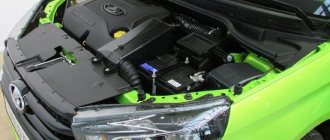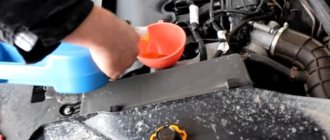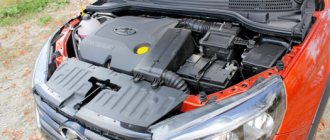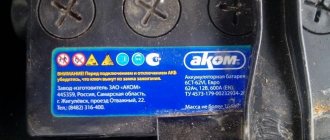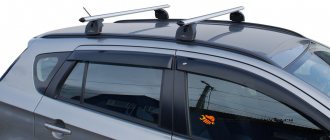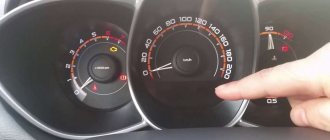The heating, ventilation and air conditioning systems of the Vesta interior are completely different models compared to similar systems operating in other Lada models. Moreover, both the design itself and the control method in these three systems are strikingly different. To begin with, we will conduct an overview analysis of the design of the Vesta stove, which will allow us to verify its effectiveness. VENTILATION AND HEATING SYSTEM
The heater radiator, designed to heat the interior of the car, is located inside the housing on the left side. If it needs to be replaced, it will be necessary to remove the upper frame (lining) of the panel (dashboard).
The cabin filter, which is located in the heater unit on the passenger side, functionally cleans the air entering the cabin. Unlike models such as Granta, Kalina or Priora, where the cabin filter is replaced from the engine compartment, on Vesta similar work is carried out from inside the car. In addition, the resource of the filter element is not the usual 15 thousand km, but 30,000 km, which is much more preferable.
Air temperature indicators in the cabin and outside send their measurements to the engine control unit (ECU). The control unit for the stove (heater) and air conditioner (SAUKU) is capable of monitoring parameters associated with temperature fluctuations in the air in the cabin, changes in the speed and direction of air flows, as well as heating controls. Depending on the configuration, the SAUKU can have three varieties:
- SAUKU with air conditioning;
- SAUKU without air conditioning;
- SAUKU with climate control (will be installed on cars a little later).
INTERIOR VENTILATION DIAGRAM Air ducts coming from the side of the stove body direct air jets to the windows, into the passenger compartment and legs. In turn, if the central deflectors are capable of controlling air flows in different vectors, then the power of these devices can be adjusted with a wheel located horizontally under them.
As for the implementation of the Vesta driver’s foot airflow system, in practice AvtoVAZ introduced an innovation by placing the air duct nozzle above the right foot, and not on the side. Some owners of the new sedan believe that such a mechanism is not entirely adequately selected, since the fingers are heated worse than the feet themselves. It is noted that the front passenger will not experience similar difficulties due to the fact that the air duct itself is closer to the wall of the engine shield. Also worthy of special attention is the option called “Cooled Glovebox”, which allows, on versions of the car with air conditioning, to cool any food or items in the glove compartment, which is achieved by connecting a small air duct to this small storage area. CONTROL ALGORITHM FOR OVEN AND AIR CONDITIONER “Classic” block without air conditioner The left regulator (No. 9) is designed to control the temperature of the supplied air. In turn, the right one (No. 17) controls the air flow. Accordingly, the buttons (No. 11-16) allow you to direct the air stream in a given mode. “Comfort” unit with air conditioning An additional advantage of this system is that if the left regulator (No. 18) makes it possible to operate the air conditioner, then the right one (No. 19) activates the air recirculation function. As for such parameters of the “Comfort” system as control of the supply air temperature, fan speed and air flow distribution, they are no different from the “Classic” version.
If you need LPG, then contact the exclusive representatives of TM Torelli in Ukraine, the Milano Ukraine company, read more on their website. “Luxe” unit with climate control Two buttons on the control unit have undergone changes: • In the “Defrost MAX” mode (No. 24), both the air conditioning (under favorable conditions) and the electric heating system are turned on forcibly, the power of which blows on the glass surfaces from the front and rear, as well as side mirrors. At the same time, the air temperature and the maximum maximum speed are set, after which the entire air stream is directed into the blower ducts of the windshield and front side windows. • In the “AUTO” mode, the activation of which depends on the external air temperature, automatic installation of parameters related to the temperature of both the cabin air and the coolant of the engine cooling system occurs, as well as the power of the air stream (fan speed) and changeable modes of air flow distribution . The information display (No. 10) can please motorists with its changes, as well as the temperature scale, in which convenient numbers have appeared instead of the usual measuring scale.
DIAGRAM OF CLIMATE INSTALLATION LADA VESTA/XRAY
Air conditioning system Lada Vesta/XRAY: 1, 2, 5 — air conditioning system pipelines; 3 — air conditioning compressor drive belt; 4, 15 — hoses of the engine cooling system; 6 - engine; 7 — air conditioning filter; 8 — air conditioner electric fan; 9 — air conditioner evaporator; 10 — air conditioner housing; 11 — radiator of the heating system; 12 — heater radiator supply hose; 13 — heater radiator outlet hose; 14 — air conditioning compressor; 16 — fan of the engine cooling system; 17 — radiator of the cooling system; 18 - air conditioner condenser.
The heater does not turn on
Lack of response to turning on the heater means: failure of the switch, the fan itself, or a blown fuse. First you need to make sure the integrity of the latter. To do this, open the block cover in the lower left part of the panel and find fuse F25 (30A), indicated in the photo:
If it is burned out, replace it with a similar one - 30A. But before this, it is strongly recommended to find out the reason; perhaps the “dying” fan motor was the culprit for the blown fuse.
Also, if the fan operates only in the last, fastest mode, the resistor unit is to blame.
(2 ratings, average 4.5 out of 5)
CHECKING THE OVEN FAN
fan speed control knob to alternately switch four speeds. We check how it blows from the air ducts as the fan speed increases.
- If the stove does not work (the fan does not rotate at all), check the fuse in the mounting block (F45).
- If only one or more fan speeds do not work, then the cause may be a faulty auxiliary resistor or vehicle wiring.
- If the stove blows poorly (the air flow intensity is low), it means that the air intake grille or the cabin air filter .
We advise you to read our articles
Problems
Stove motor During operation, the device may become unusable or reduce its efficiency.
We check the fan at all four speeds:
- if the fan stops rotating, look at the safety element in the control unit;
- if one of the speeds does not work, the reason is a breakdown of the additional resistor or car wiring.
- When the fan operates at low intensity, you need to clean the air intake grille or filter.
We check the dampers - at maximum speed, use the keys to change the distribution modes:
- if they do not move, the problem is in their electric drive;
- If the Lada Vesta heater dampers squeak, you should lubricate them with silicone grease.
We warm up the engine to operating temperature, then watch how the pipes are heated. The problem lies in the different temperatures of these elements:
- minimum antifreeze level is likely;
- you need to force out the air plug through a specialized valve;
- If the radiator is clogged, replacement is necessary.
CHECKING HEATING EFFICIENCY
We start the engine and warm it up to operating temperature . We check that the inlet and outlet pipes of the heater radiator are heated and have approximately the same temperature. If the pipes have different temperatures, then it is possible:
- low coolant level in the expansion tank (which antifreeze is better)
- An air lock has appeared in the engine cooling system (air can be released through a special valve)
- Heater radiator clogged (replace)
We install the temperature regulator on the stove control unit all the way to the red zone. We make sure that the temperature of the air leaving the panel deflectors begins to rise. If it blows cold, it means:
- The damper drive is faulty (the damper does not open,
- preventing the passage of air through the heater radiator)
- The heater control unit is faulty (how to remove)
Articles about tuning Lada Xray
Work progress
Self-installation of a large air filter on a Lada Vesta begins with modification of the housing itself. First of all, it is necessary to solder the factory hole through which air is taken in.
Next you need to solder the purchased pipe. You can do this in different ways - using epoxy resin, soldering a metal mesh, using a stapler, etc. But in general, soldering using a metal mesh provides the most durable fixation.
Next you need to connect the sewer pipes and outlets.
To prevent the connector from interfering with the installation of the filter housing, it must be recessed and secured with a tie.
All that remains is to put in place the homemade air intake, constructed from sewer components, install it with the desired slope and secure it with a clamp.
Then you need to move the car’s battery to the right and back until it stops, since otherwise it will interfere with the installation of the large air filter housing on the Vesta.
The case itself needs to be tightly fixed, and to do this, place it in such a way that the rear legs rest on the corrugation with wires.
This completes the independent installation of a large air filter on the Lada Vesta.
WHY DO GLASSES FOG?
The car windows should not fog up while the heater is operating If this happens, then the cause may be:
- heater core leaking
- cabin filter is clogged
- The electric recirculation air damper actuator is faulty
No matter what AVTOVAZ PR people say, the LADA Vesta, in accordance with the traditions of the Soviet automobile industry of the last century, turned out to be a “crude” car - with a lot of design flaws and quality defects. One of the global “jambs” that causes a lot of complaints - the clutch and manual gearbox - AVTOVAZ has already begun to change it to “more different ones”. It is not yet known whether this step will remove the claims of car owners about their reliability and smooth operation. It’s good that the company, although a year late, is trying to make its car better.
The heating, ventilation and air conditioning system of the Vesta's interior differs from similar systems of other Lada models. The difference is not only in its design, but also in the control method. Let's look at the design features of the Vesta stove, and also evaluate its effectiveness.
Finalization
And now, another way has appeared - a cold intake and a large air filter on the Lada Vesta, the same as the one on the Sport modification. The peculiarity of this method is that it is suitable for both engines of the model - 1.6 and 1.8 liters.
Lada Vesta Sport has an enlarged air filter created specifically for this version. In addition, this modification has a different air intake location - it is located next to the left headlight behind the radiator grille.
Elements of the ventilation and heating system
The stove body (in Fig. No. 5) is located in the car interior under the instrument panel frame. Inside the case there are:
- heater radiator;
- electric fan;
- fan speed controller (RFV) or additional resistor;
- air flow distribution damper;
- gear motor that regulates the dampers;
- air filter.
The heater radiator releases heat to heat the interior. Located inside the case on the left side. To replace it, you will have to remove the upper frame (lining) of the panel (dashboard).
Components
The entire Lada Vesta Sport air filter kit consists of a number of elements. Their names and articles are presented in the table.
| Air filter half housing (upper) | 8450032859 |
| Filter element | 8450032860 |
| Semi-housing (lower) of the air filter | 8450032858 |
| Bolt | 7703008226 |
| Screw M6x30 | 8450002332 |
| Washer 6x18 | 8450003738 |
| Elastic bushing for fixing the electric fan | 8450001134 |
| Intake pipe hose assembly | 8450032835 |
| Screw clamp assembly | 8450001108 |
| Clamp 16 | 7703083470 |
| Hose (upper) crankcase exhaust ventilation | 8450008594 |
| Connection pipe | 8450101902 |
| Air intake assembly | 8450032837 |
| Screw clamp assembly | 8450001108 |
| Connection pipe | 8450032838 |
| Washer 6x18 | 8450001123 |
| Bolt M6x25 | 8450006008 |
Interior ventilation diagram
Air ducts run from the stove body, which direct air flows to the windows, into the interior and legs. The central deflectors can adjust air flow in different directions, and its strength is controlled using a horizontal wheel underneath them.
AvtoVAZ has implemented airflow for the Vesta driver’s feet in a new way. The air duct nozzle is located not on the side, but above the foot of the right foot. Some owners of the new sedan believe that this design is not very successful, because It warms the toes worse than the foot itself. For the front passenger, the air duct exits closer to the wall of the engine shield and a similar situation will not arise.
Worth o. On versions of the car with air conditioning, a small air duct fits into the glove compartment, which can cool, for example, a water bottle.
see also
Comments 26
The cabin filter is probably clogged. I changed it and it helped. We have minus 40 in winter. The bottom left button is on.
Found a video as a solution to the problem
As an option. Haven't you tried it? Because this feature infuriates me. All the way to the feet and the fan in the middle. It blows like a scribe.
Found a video as a solution to the problem
And there really is a bad wind in my legs. It became noticeable especially with the cold weather.
I'll tell you my observations. The coolant temperature is maintained at 82 degrees. When moving, it can drop to 75. I installed YarPlast winter protection on the lower part. The temperature became higher than 82 - 95 degrees. It has become much warmer in the car, but it works up to - 8 -10 It should be noted that turning on the first fan speed is 100 and turning it off is 96. This suggests the thought that the engine is operating in incomplete warm-up mode...
I'm also not happy with the heating. precisely the fact that when translated “blowing at the feet” it also blows on the glass. This Feature of AvtoVAZ is annoying... If you turn it on your feet and yourself. and closing the deflectors is fine. Are there any ways to overcome this feature?
And I have a luxury. It blows wherever I want.
It's not true. Most likely you didn't check. I checked this with my manager on 3 machines with different configurations. There's a little bit of an uplift on everyone! turn on the airflow only for the legs, and the fan to medium, and then to maximum. You will be convinced!
That's not what I was talking about. In the suite you can turn on all the buttons at the same time.
In short, the answer was here. Only at AvtoVAZ this is a feature. I checked and compared the algorithm of work on the Test Drive West with full stuffing and on the empty one. It's the same everywhere. The manager's answer sounded like this: Either you get used to the car and drive, or you get rid of it. On AvtoVAZ this feature is specifically designed to prevent the windows from fogging up. He also confirmed that this does not happen on other cars. For me, such an algorithm is bullshit. Since there is a separate button for turning on the windshield and foot airflow.
Departing from the topic, I’ll say one more piece of news: the driver’s lower air duct has now been changed (for better airflow of the driver’s right foot).
Heater and air conditioner control
“Classic” block without air conditioning
Left regulator (No. 9) – supply air temperature control; Right (No. 17) - air flow regulation; Buttons (No. 11-16) - setting the direction of air flow.
Comfort unit with air conditioning
The left regulator additionally has the function of turning on the air conditioner (No. 18), and the right one has the function of turning on air recirculation (No. 19). Otherwise, the control of supply air temperature, fan speed and air flow distribution of the Comfort version of the system is similar to the Classic version.
Luxe unit with climate control
Two buttons are replaced on the control unit:
- “Defrost MAX” mode (No. 24) - the air conditioning is forcibly turned on (if conditions permit), electric heating of the windshield and rear windows and side rear-view mirrors. The entire air flow is directed to the blower nozzles of the windshield and front side windows, and the maximum speed and air temperature are set.
- “AUTO” mode - in this mode, the air flow intensity (fan speed) and one or another air flow distribution mode are automatically set depending on the outside air temperature, the cabin air temperature and the coolant temperature of the engine cooling system.
The information display (No. 10) has also undergone changes; the air temperature scale has been replaced with numbers.
Heated seats.
These are simple buttons
these are 3 position
In general, an electrician is needed.
Lada Vesta SW Cross 1.8 5MT Luxe Multimedia Mars
How does the morning begin in winter? When others clean the windshield with plastic cards, the windshield heating on Vesta turns on. Snow covering roads and vehicles, coupled with low temperatures, causes inconvenience for motorists - they tried to solve this problem with the Lada Vesta. Russia is famous for its harsh winters. AvtoVAZ tried to adapt the new models to the winter season. The Lada Vesta engine starts even in 30 degree frost, and the design of the locks prevents freezing. Additional options on the luxury model, such as a heated windshield, rearview mirrors and seats, are a bonus for drivers. In cold weather, you don’t need to manually remove snow and ice deposits with a scraper; just turn on the heated windshield. On the Lada Vesta, heating will quickly and easily remove snow and ice. It is also recommended to use this function in a blizzard with snow, to remove excess load from the mechanism driving the wipers. Read the article to the end and find out how to enable it, how it works and what problems are encountered with this function!
Reviews about the Vesta stove
The first reviews from Vesta owners about the stove are generally positive. No significant deficiencies were identified. The car warms up quickly. It blows quite strongly from all the air duct nozzles. In cold weather at -25 degrees, the car interior is warm and comfortable. When using the control unit and adjusting the deflectors, the cost of the parts is not visible; in terms of quality, it resembles a foreign car.
To improve the efficiency of the heater, close the glove compartment cooling in winter:
Let us remind you that with the first cold snap we were also able to test the operation of the heating. You can find other information about Vesta that interests you in this content. By the way, problems with the operation of the stove can be caused by an air lock in the cooling system.
How does your Vesta’s stove heat? In the comments to the article we leave impressions and notes about the efficiency of the heater.
Results
In severe frost (at -20 degrees), the thawing order will be approximately as follows:
- 1 minute – the ice on the mirrors begins to melt;
- 2.5 minutes – the ice on the mirrors has almost melted, the bottom of the windshield (stove) begins to thaw;
- 4 minutes – the mirror elements are completely dry, the snow on the threads of the rear window will melt;
- 5-6 minutes – the windshield and areas on the side windows near the mirrors noticeably move away from the ice;
- 7-8 minutes - the heating has melted the ice from the main part of all the windows, you can drive.
In warmer weather, you can start driving earlier, as soon as the engine speed drops to operating speed. There are no comments on the operation of Vesta’s heating; one can only find fault with the fact that the seat heating is not adjustable.
Theme Options
Search by topic
The Lada Vesta car has a stove heater…
...designed to heat the car interior. The stove is also actively used during rain or cold weather.
The heater is also activated if necessary to quickly remove fogging from the windows or warm up passengers. In the “Lux” configuration, the car is additionally equipped with air conditioning, which creates a favorable temperature for a person.
The most common malfunctions of the Lada Vesta heater radiator: leakage, fan noise, engine vibration. The replacement process is not complicated, but requires care on the part of the repairman.
Effect
If you consider the reviews of the owners who went through with this modification, it becomes clear that the effect is quite noticeable. They note that the engine begins to “breathe”, and not only at the bottom, but also works more vigorously after 3,000 rpm.
The engine revs noticeably easier up to 5,000 rpm. Those who often drive in traffic jams claim that the car has stopped shaking in traffic jams.
In general, installing a large air filter on your Lada Vesta yourself is completely worth it, especially if you don’t buy branded products.
Rate the article!
How the stove works on Lada Vesta. Device
- The heater radiator is connected to the system main via rubber pipes. The heat emitted by the internal combustion engine is transferred to the heating system.
- The heating system radiator distributes heat throughout the car interior using an electric fan.
- A preset resistor online regulates the fan rotation speed.
- The air flow is circulated and cleaned by a mesh and cabin filter (see diagram).
- With the help of installed dampers, the driver and passengers regulate the air flow flowing to them.
- The gearmotor rotates the damper based on the readings of the regulator and heater sensors.
Alternative
If the problem lies precisely in the side of the carpet, you can refuse to modify the rear air ducts in the Lada Vesta and X Ray and work with it. Some car owners simply cut out a piece of the side. This is effective, but looks unaesthetic.
But there is another option. It is necessary to cut small round holes in the side, just opposite the air duct, and insert rubber bushings into them.
As you can see, there are several options for modifying the rear air ducts in the Lada Vesta and X Rey. Therefore, car owners who are faced with this problem can choose the method that they consider optimal.
However, one of the owners of Vesta, whose name is Evgeniy and is known on Drive under the nickname gps-nav, found an alternative way of installing a large air filter on the Lada Vesta, which is several times cheaper. It involves purchasing components from different cars and their subsequent modification.
Elements:
- filter element - Filtron AP 074/3 is suitable - 330 rubles;
- air filter housing from the Ford Mondeo 3 model – 600 rubles – can be purchased under article number 4609885902;
- air filter pipe from the VAZ 2111 model – 700 rubles;
- sewer pipe 75 mm and sewer bends 90° and 67° – 220 rubles;
- fitting - 30 rubles;
- plastic ties (2 units) and a metal clamp (2 units).
After all the listed components have been purchased, you can begin work.
Typical stove malfunctions
The most common problems with the stove on Lada Vesta are the following:
- the actual temperature does not correspond to the set one - low level of antifreeze (antifreeze), clogged radiator pipes or the formation of an air lock, which causes cold air to blow;
- vibration appears during operation - the electric motor is loose;
- insufficient air flow from the deflectors - clogging of channels and air ducts;
- the heater is inactive when it is activated on the dashboard - failure of the fuse (No. 14) of the mounting block.
Checking the stove fan
During the circulation of the air flow, dust particles settle on the surface of the impeller, as a result of which it begins to make noise and extraneous sounds appear.
To clear the fan blades of debris, it is necessary to provide access to the unit.
- Unsnap the glove box.
- Remove the filter element.
- On the right is the furnace mechanism. We press the plastic clips and turn the impeller counterclockwise.
- We remove the motor.
- We wipe the drive with a rag.
- Install the parts in reverse order.
Checking the stove dampers
Dampers are installed in the area between the deflectors and the fan. During operation, they fail, become deformed, and become damaged. Checking the serviceability of the damper on your own is quite simple: you need to activate the stove at maximum speed. If it doesn't blow well, it means the air duct is clogged. Change the damper positions. If you hear squeaking or noise, lubricate the moving parts with silicone grease.
Foggy windows when the heater is activated is the first sign of a ventilation problem. This problem provokes a sharp decrease in visibility on the road and an increase in the risk of an emergency. As soon as fogging is detected, check the condition of the ventilation; most likely, the air ducts are clogged.
Checking heating efficiency
Carry out prevention before the onset of winter. Be sure to check:
- heating the air;
- changing speed modes when switching the control lever, if necessary, replace the brushes of the stove motor;
- absence of extraneous noise, whistling in fan operation;
- the need for a time interval to warm up the air ducts.
Connection
In this case, it is necessary to ensure that the floor lighting on the Lada Vesta and X-Ray works in the same way as the rest of the car, that is, it fades out when the doors are closed. Otherwise, the constantly burning backlight will begin to irritate and tire you, especially on a long night journey.
In this case, there are 2 connection options:
- To CBKE;
- To the ERA-GLONASS lamp.
To CBKE
The connection goes to plug P1, contact C4 (the red wire goes into it) - 12V, provided the car is disarmed. Plug P1, contact C6 (a white wire goes into it) – when the door is opened, a “ground” gradually appears.
The location of the electronics box varies depending on the model.
Lada Vesta
In a sedan it is located behind the glove box, and therefore, in order to get to it, the glove compartment must be removed. To do this, you need to open the glove box lid, then release the latches that hold its upper edge. When this is done, the lid pulls towards itself, overcoming the resistance of the 3 fasteners, and snaps off.
Vesta glove box mount
Next you need to remove the glove box light. It is located in the upper left corner and is held in place by a spring-type lock. You need to pry up the lampshade with a knife or screwdriver and snap it off, then disconnect the wiring.
When the ceiling light is removed, you only need to unscrew the 5 mounting screws that secure the glove compartment to the dashboard. This is done using a T20 Torx bit.
Lada X Ray
In this case, everything is simpler, since the electronics unit is located on the left side of the dashboard, at the driver’s feet.
To the ERA-GLONASS lamp
First you need to remove the lampshade itself. Before work, you must reset the negative terminal from the battery.
Next, you need to insert a screwdriver or knife between the roof upholstery and the lampshade, with the help of which you can disengage the latches.
Then unscrew the 2 screws that secure the lampshade to the body, and pry off the spring retainer (also with a knife or screwdriver). In the end, all that remains is to disconnect the plug.
For greater convenience of connecting the floor lighting (and other devices) to the Lada Vesta and X-Ray through the lampshade, the plug is numbered. It is recommended to navigate by the number, since the color of cars of different years of assembly and configuration may differ.
Diagram of the ERA-GLONASS lighting unit
Connection:
- Contacts 11 and 14 (usually white-pink color) - after turning on the main relay (opening the doors, turning the key in the ignition switch), +12 V appears. A few minutes after the key is removed from the ignition switch, the power stops.
- Contact 15 (usually blue-black or black) – ground;
- Contact 17 (usually white) – mass of door limit switches. It occurs only when the doors are open.
The implementation of floor lighting on the Lada Vesta is demonstrated in the video.
Replacing a stove radiator with your own hands on a Lada Vesta
Preparation of the workplace, necessary tools:
- rags;
- Phillips head screwdriver;
- flashlight to increase visibility;
- new radiator.
How to remove a radiator. Replacement sequence:
- We turn off the engine, turn off the ignition, and squeeze the parking brake.
- Open the hood and remove the terminal from the battery.
- We grind off the antifreeze from the system. The plug is located at the bottom point of the radiator (key 17).
- We remove the decorative trim on the instrument panel.
- Remove the top decorative trim above the glove box. Let's take it out.
- We dismantle the metal dashboard support on the driver's side.
- Remove the air pipe.
- Open the stove lid.
- We remove the heater.
- We install a new heater radiator.
- We assemble the structure in reverse order.
Dashboard Lada Vesta
On a Lada Vesta, the instrument cluster is very different from older Lada models. Therefore, this description will help you understand the meanings of indicators and instrument readings.
- Tachometer. Shows the engine crankshaft speed (x1000 min-1). The presence of the tachometer needle in the red scale area warns of increased engine speed. To prevent damage to the engine, its maximum speed is limited by the electronic engine management system software. Above approximately 6200 min-1 the fuel supply will be limited. Possible interruptions in engine operation and jolts in the movement of the vehicle are not a malfunction. When the rotation speed decreases, the fuel supply will resume. Also, do not allow the engine to operate when starting and while driving at an engine speed below 800 min-1. (ATTENTION! It is prohibited to operate the engine in a dangerous mode (at engine crankshaft speeds above 6200 min-1 and below 800 min-1).
- "Seat belt" warning light
- Warning light "Airbag system"
- Brake failure indicator
- "Electric power steering" warning light
- "Engine fault" indicator
- Battery indicator
- ABS warning light
- Speedometer
- Warning light "Unclosed hood"
- Signal indicator "Hazard alarm"
- Signaling device "Unclosed doors"
- Right and left turn signal indicators
- LCD indicator with functions
- Index "Coolant temperature". Operating a vehicle with a faulty warning light is prohibited. When the operating temperature of the coolant is exceeded (more than 115 °C), the indicator lights up red constantly, and a short-term intermittent buzzer sounds. Do not allow the engine to operate in overheating mode. (WARNING: Do not operate the vehicle with an overheated engine. The vehicle must be taken to a dealer to determine and correct the cause of the engine overheating.)
- Fuel level indicator and indicator
- Signal indicator "Parking lights"
- Signal indicator "Low beam headlights"
- Signal indicator "High beam headlights"
- Signal indicator "Front fog lights"
- Signal indicator "Rear fog lights"
- "ESC" indicator
- "ESC OFF" indicator
Review of Manufacturer Prices
Dimensions: 184x133.5x26 mm.
| Serial number/item | Price in rubles |
| LUZAR 271153553R (original) | From 5000 |
| STELLOX 10-35126-SX | From 4500 – 4700 |
| FENOX RO0004C3 | From 4500 – 4700 |
| RO0003O7 | From 4500 – 4700 |
| AVA QUALITY COOLING RTA6398 | From 4500 – 4700 |
| VALEO 812374 | From 4500 – 4700 |
| NISSENS 76512 | From 4500 – 4700 |
| MAGNETI MARELLI 350218221003 | From 4500 – 4700 |
| *prices are as of May 2022 | |
